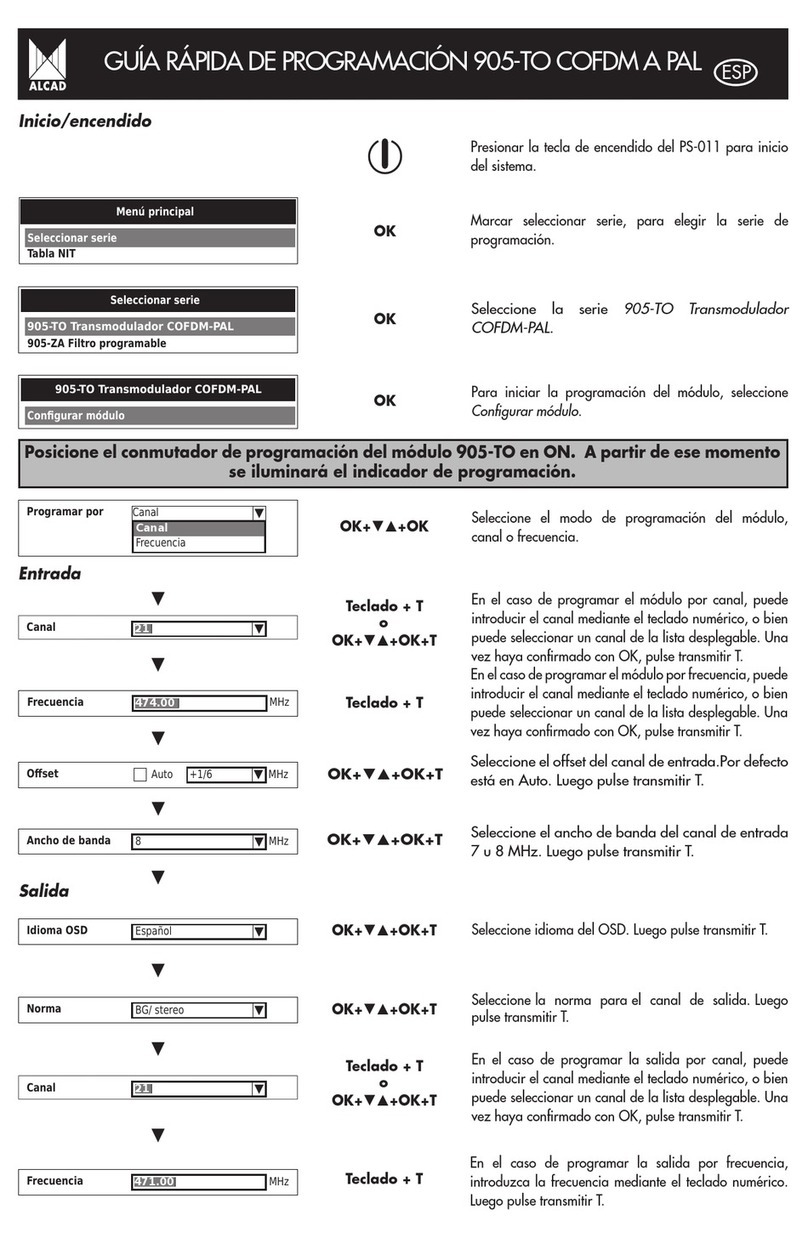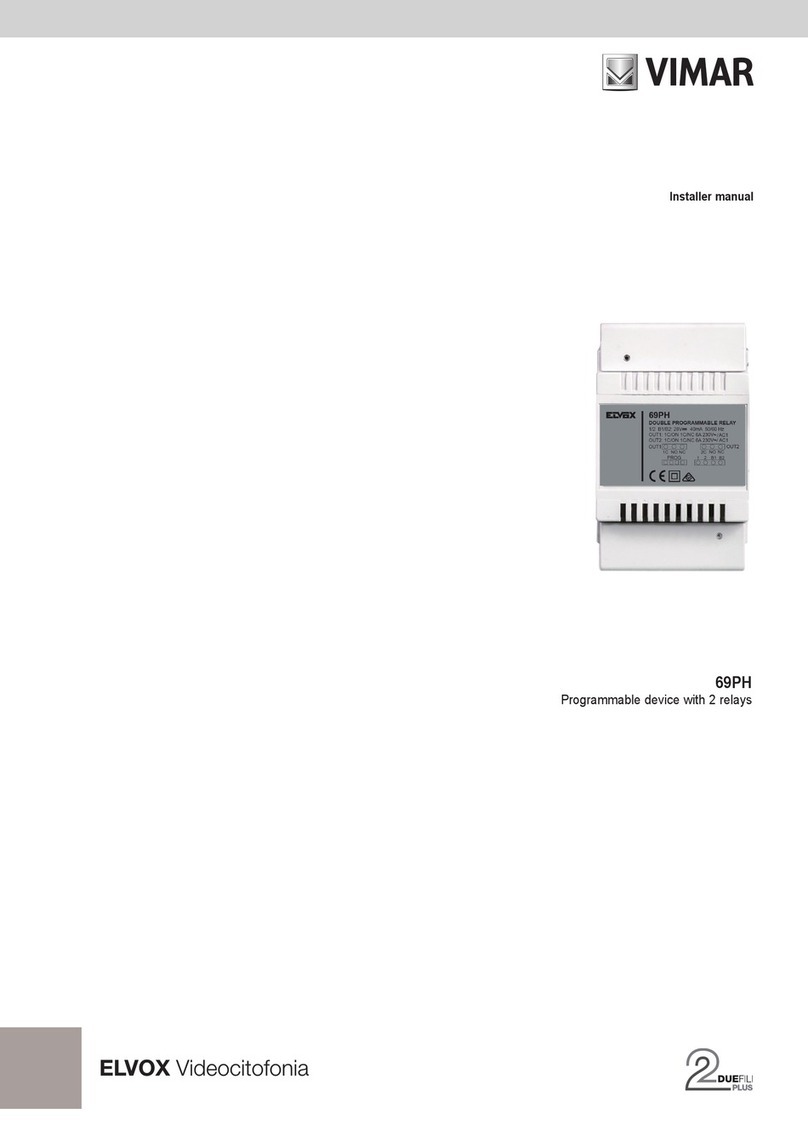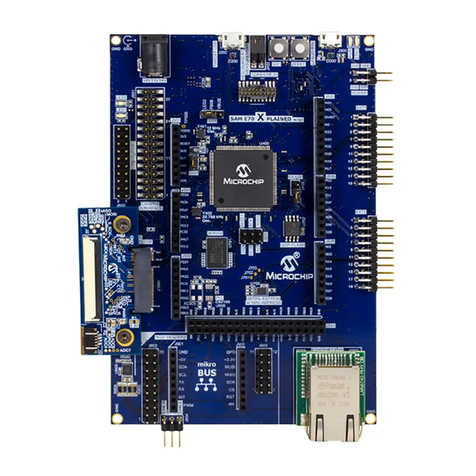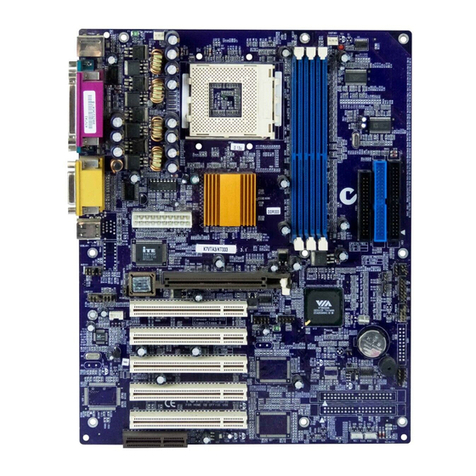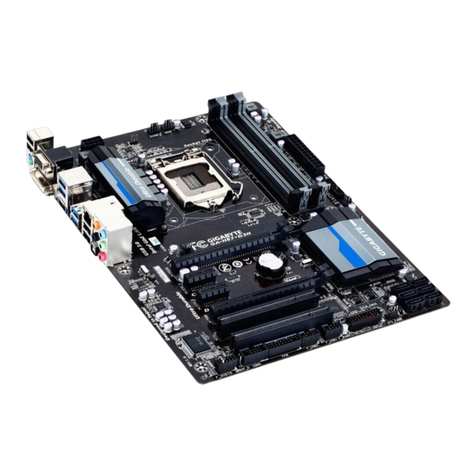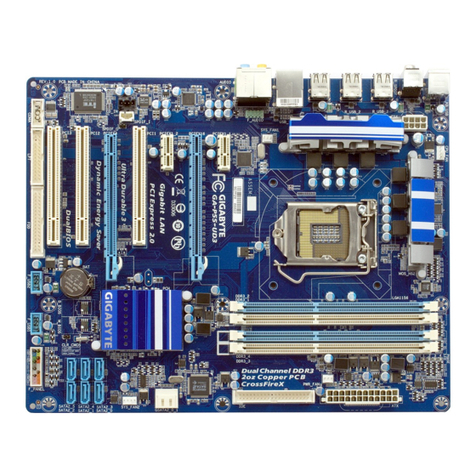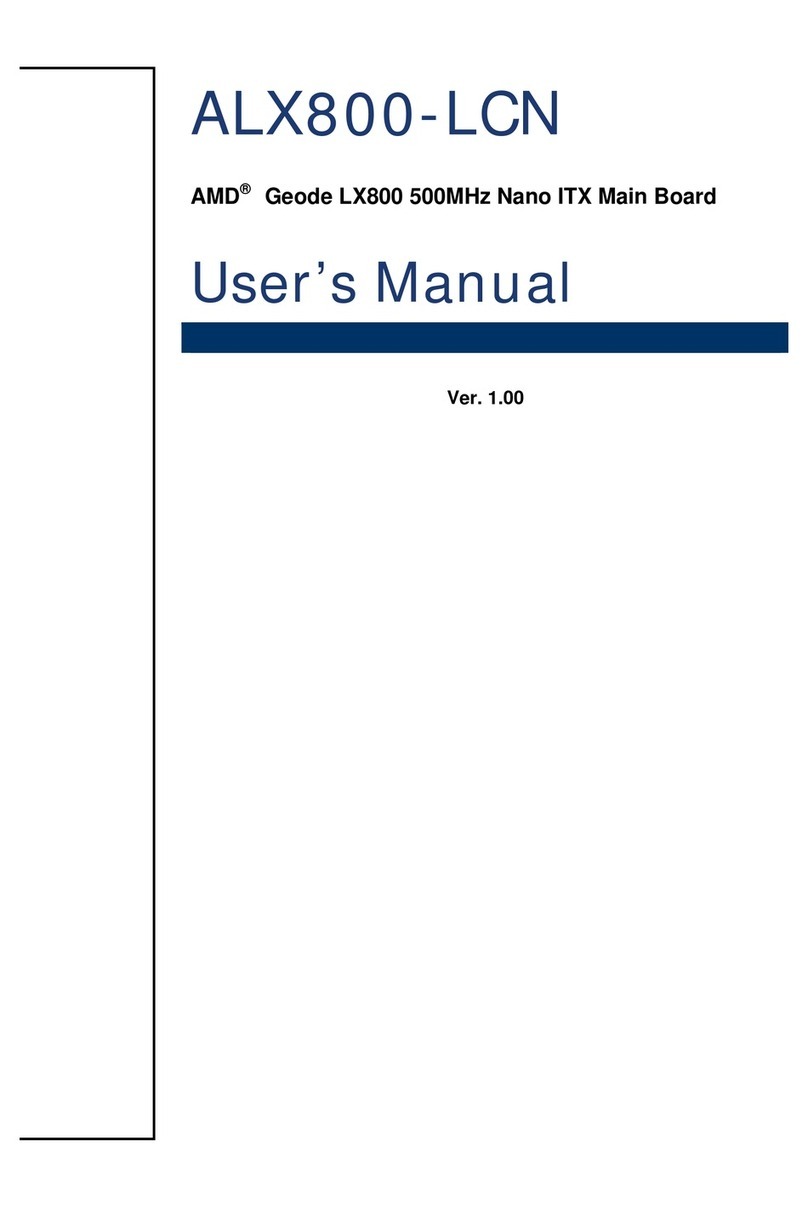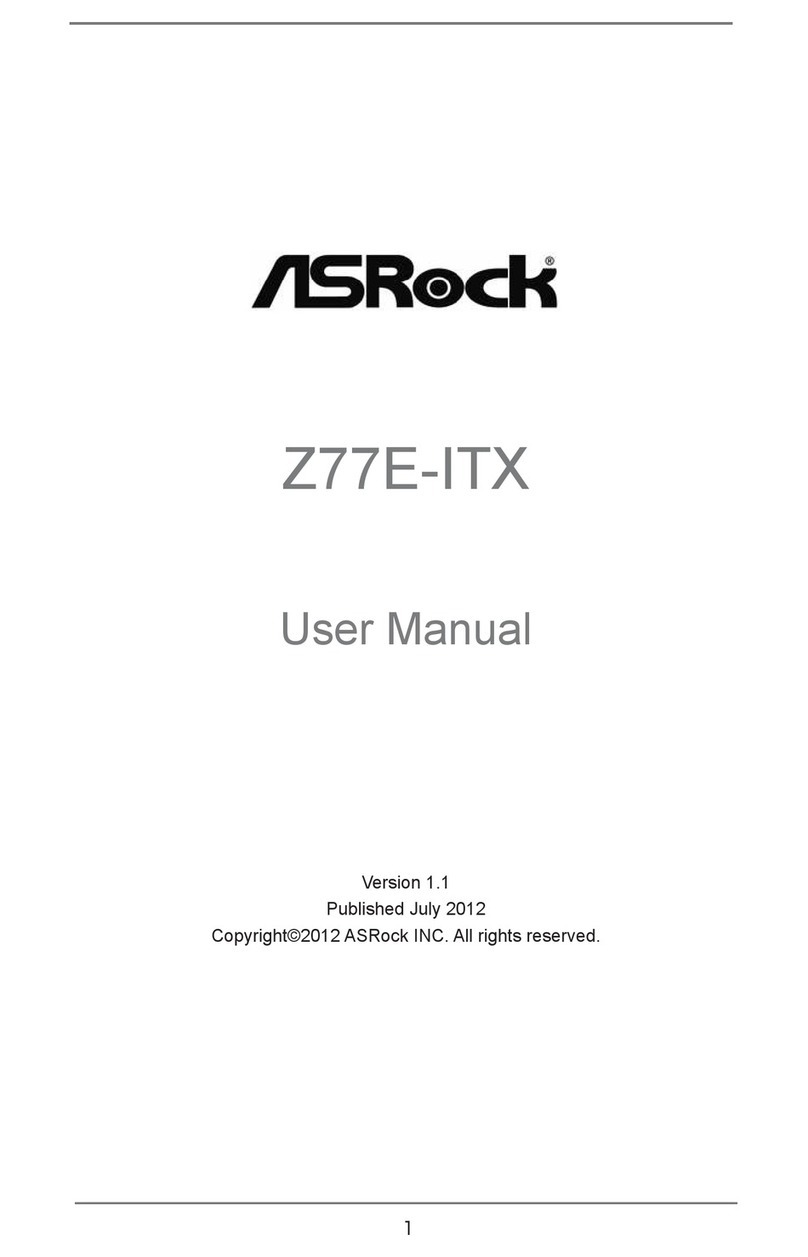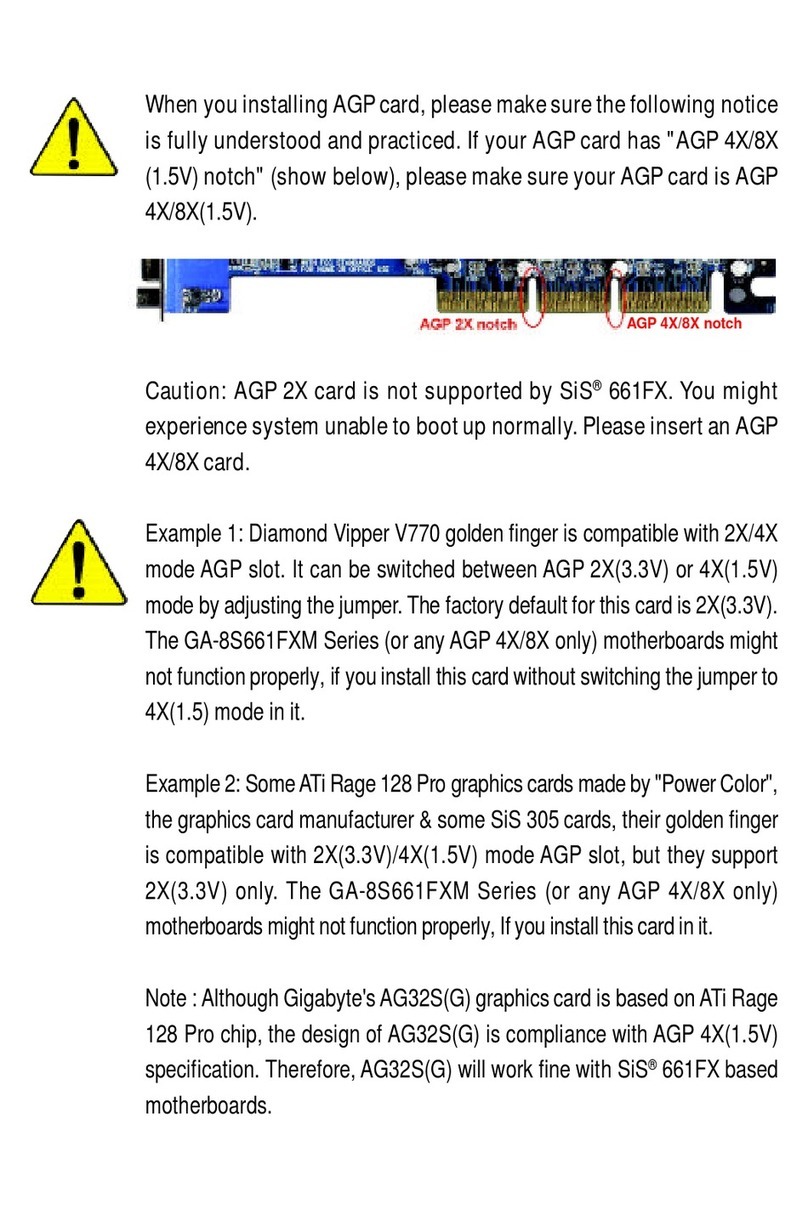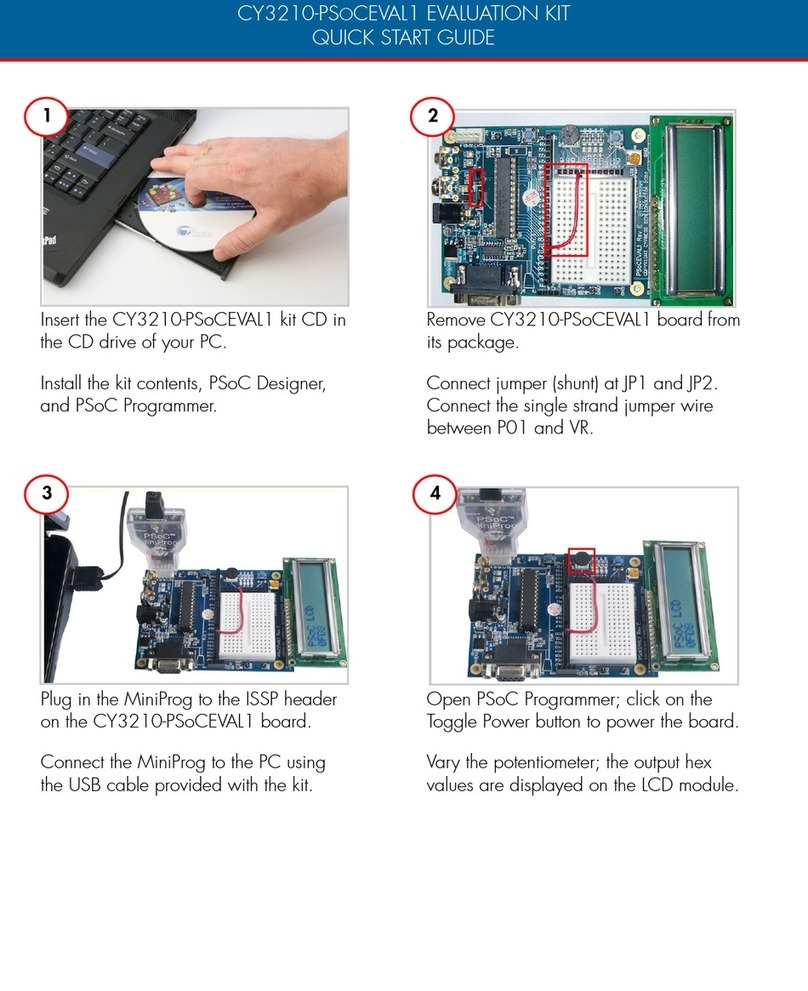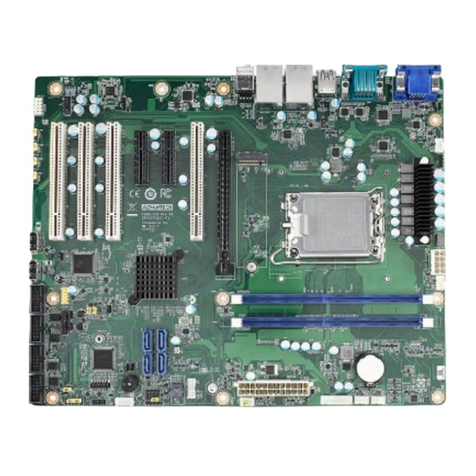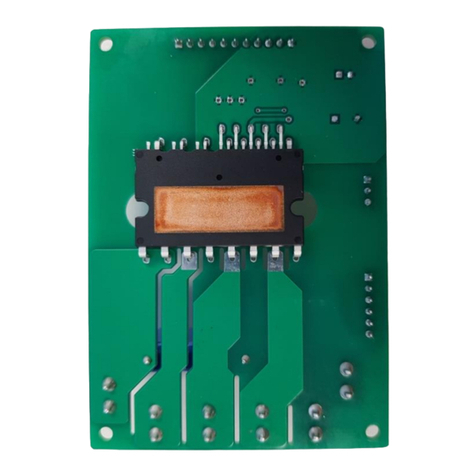Technologic Systems TS-3300 User manual

TS-3300 User’s Manual

Technologic Systems, Incorporated
16525 East Laser Drive
Fountain Hills, AZ 85268
480-837-5200
FAX 837-5300
http://www.embeddedx86.com/
This revision of the manual is dated
May 21, 2009
All modifications from previous versions are listed in the appendix.
Copyright © 1998-2008 by Technologic Systems, Inc. All rights reserved.

TS-3300 User’s Manual Technologic Systems
05/21/09
ii
Limited Warranty
Technologic Systems warrants this product to be free of defects in material and workmanship for a
period of one year from date of purchase. During this warranty period Technologic Systems will repair or
replace the defective unit in accordance with the following instructions:
•Contact Technologic Systems and obtain a Return Material Authorization (RMA) number and a copy
of the RMA form.
•Fill out the RMA form completely and include it and dated proof of purchase with the defective unit
being returned. Clearly print the RMA number on the outside of the package.
This limited warranty does not cover damages resulting from lighting or other power surges, misuse,
abuse, abnormal conditions of operation, or attempts to alter or modify the function of the product.
This warranty is limited to the repair or replacement of the defective unit. In no event shall
Technologic Systems be liable or responsible for any loss or damages, including but not limited
to any lost profits, incidental or consequential damages, loss of business, or anticipatory profits
arising from the use or inability to use this product.
Repairs made after the expiration of the warranty period are subject to a flat rate repair charge and the
cost of return shipping. Please contact Technologic Systems to arrange for any repair service.

TS-3300 User’s Manual Technologic Systems
05/21/09
iii
Table Of Contents
LIMITED WARRANTY.......................................................................................................................................................................................II
1INTRODUCTION ................................................................................................................................................................................... 5
2PC COMPATIBILITY.............................................................................................................................................................................. 5
2.1 Operating Systems.......................................................................................................................................................................... 5
3POWER................................................................................................................................................................................................... 6
4MEMORY................................................................................................................................................................................................. 6
4.1 SDRAM............................................................................................................................................................................................... 6
4.2 Flash.................................................................................................................................................................................................. 6
4.3 Compact Flash cards and DiskOnChip modules..................................................................................................................... 6
4.4 Using the SanDisk USB Compact Flash Card Reader ......................................................................................... 7
4.5 Battery-Backed SRAM ............................................................................................................................................................ 7
5SERIAL PORTS ..................................................................................................................................................................................... 7
5.1 Serial Port Configuration Registers............................................................................................................................................. 7
5.2 Serial Port Hardware....................................................................................................................................................................... 8
5.3 RS-485 Support............................................................................................................................................................................... 8
5.4 Adding Serial Ports.......................................................................................................................................................................... 9
6DIGITAL I/O............................................................................................................................................................................................. 9
6.1 DIO1 Header..................................................................................................................................................................................... 9
6.2 DIO2 Header...................................................................................................................................................................................10
6.3 Using LCD Port as Digital I/O......................................................................................................................................................10
6.4 DIO on the PC/104 bus.................................................................................................................................................................11
7LCD INTERFACE ................................................................................................................................................................................11
8MATRIX KEYPAD SUPPORT.............................................................................................................................................................12
9A/D CONVERTER................................................................................................................................................................................12
9.1 Single Sample Acquisition Procedure.......................................................................................................................................13
9.2 A/D Converter BIOS Call...............................................................................................................................................................13
10 THE 10 BASE-T ETHERNET PORT.................................................................................................................................................13
11 REAL TIME CLOCK.............................................................................................................................................................................15
12 WATCHDOG TIMER AND SOFTWARE RESET.............................................................................................................................16
13 LED AND JUMPERS...........................................................................................................................................................................17
14 PC/104 BUS EXPANSION .................................................................................................................................................................18
15 LOADING OR TRANSFERRING FILES...........................................................................................................................................19
15.1 Developing with the Technologic Systems TS-9500..............................................................................................................19
15.2 Transferring files with Compact Flash......................................................................................................................................19
15.3 Zmodem Downloads....................................................................................................................................................................19
15.4 Manufacturing Mode......................................................................................................................................................................20
16 DEBUGGING........................................................................................................................................................................................20
16.1 Integrated BIOS Debugger...........................................................................................................................................................20
16.2 Using other debuggers ................................................................................................................................................................21
17 VIDEO, KEYBOARD, AND CONSOLE REDIRECTION.................................................................................................................21
18 SYSTEM BIOS SETUP SCREENS...................................................................................................................................................22
19 FEEDBACK AND UPDATES TO THE MANUAL .............................................................................................................................24
APPENDIX A - BOARD DIAGRAM AND DIMENSIONS............................................................................................................................24
APPENDIX B - OPERATING CONDITIONS...............................................................................................................................................24
APPENDIX C - SYSTEM MEMORY MAP .....................................................................................................................................................25
APPENDIX D - SYSTEM I/O MAP .................................................................................................................................................................26
APPENDIX E - BIOS INTERRUPT FUNCTIONS ......................................................................................................................................27
Int 15h / Function B000h - Technologic Systems BIOS information...............................................................................................27
Int 15h / Function B010h - LED Control................................................................................................................................................27
Int 15h / Function B042h – Alphanumeric LCD Support...................................................................................................................28

TS-3300 User’s Manual Technologic Systems
05/21/09
iv
Int 15h / Function B040h – Matrix Keypad Support.............................................................................................................................28
Int 15h / Function A1h – Console I/O Redirection..............................................................................................................................28
Int 15h / Function B021h – JP5 Status .................................................................................................................................................29
Int 15h / Function B020h - Jumper Pin Status....................................................................................................................................29
APPENDIX F - DIRECT CONTROL OF THE 386EX DIO PINS..............................................................................................................30
APPENDIX G - USING A 16.5 MHZ BAUD CLOCK ..................................................................................................................................31
APPENDIX H - FURTHER REFERENCES................................................................................................................................................32
APPENDIX I - MANUAL REVISIONS ...........................................................................................................................................................32

TS-3300 User’s Manual Technologic Systems
05/21/09
5
1 Introduction
The model TS-3300 is a compact, full-featured PC compatible Single Board Computer based on the
Intel 386EX processor. At 33 MHz, it is approximately 40% faster than our 2000 series of 25 MHz 386EX
based products. PC compatibility allows for rapid development since you can use standard PC
development tools such as Turbo C or Power Basic or Linux based tools as well. If you have done work
in the PC world in the past, you will find you can now build applications for a very small target that does
not require a keyboard, video, floppy disks, or hard drives.
By adding the optional TS-9500 daughter board, you can compile and debug directly on the TS-3300
with standard VGA video and keyboard interfaces. Alternatively, you can typically write and debug code
on a host PC using standard development tools for the PC platform, then simply copy it to and run it on
the TS-3300 without modification. If additional peripherals are required, the PC/104 expansion bus
allows for many standard functions available off-the-shelf. It is also very simple to create a custom
PC/104 daughter board for those special features that differentiate your product. Technologic Systems
can provide technical support as well as a free quotation for any custom hardware, software, or BIOS
modifications you may require.
This manual is fairly short. This is because for the most part, the TS-3300 is a standard x86-based PC
compatible computer, and there are hundreds of books about writing software for the PC platform. The
primary purpose of this manual is documenting where the TS-3300 differs from a standard PC.
2 PC Compatibility
PC compatibility requires much more than just an x86 processor. It requires PC compatible memory
and I/O maps as well as a PC compatible BIOS. The General Software EMBEDDED BIOS offers a high
degree of compatibility with past and present BIOS standards allowing it to run off-the shelf operating
systems and application software.
The EMBEDDED BIOS has been tested with all major versions of DOS, including MS-DOS, DR-DOS,
and Embedded DOS 6-XL; all major versions of OS/2, including MS-OS/2 and IBM OS/2; MS -Windows
3.1, Windows-95, Windows NT, and NetWare 386.
2.1 Operating Systems
Technologic Systems Embedded PCs are compatible with a wide variety of x86-based operating
systems. A partial list OSes currently used with our boards by customers includes:
•TNT Embedded Toolsuite, Phar Lap Software
•UCos II
•RTKernel, On Time Software
•RTEMS, On-Line Applications Research Corporation
•DOS with WATTCP, public domain TCP/IP source code for DOS
•Linux
The TS-3300 is shipped, free of charge, with Embedded DOS ROM by General Software.
The TS-3300 can be shipped upon request with Linux pre-installed for a nominal fee. The Linux file
system and kernel is also freely available on the web should you wish to install it yourself. Typically, the
Linux OS requires a 16MB or larger Compact Flash or an M-System’s DiskOnChip.

TS-3300 User’s Manual Technologic Systems
05/21/09
6
3 Power
The TS-3300 requires regulated 5VDC at 800 mA (typical). A quick release screw-down terminal block
for the 5V power and power GND connections is provided for easy connection to an external power
supply.
When power is first supplied to the TS-3300, the board mounted LED is immediately turned on under
hardware control. Once the processor begins execution, the LED is turned off. The LED then turns on
then off to provide a characteristic blink during execution of POST. If the LED does not turn on at all, the
most likely problem is the power supply. Check that the +5V and GND connections are not reversed. A
diode protects the board against damage in such a situation, but it will not run.
Please note that supply voltages over 6 VDC may damage the TS-3300. Be sure to use a regulated 5
VDC power supply.
4 Memory
4.1 SDRAM
The TS-3300 has a total of 8 Megabytes (MB) of high-speed SDRAM providing 640 Kilobytes (KB) of
base memory, 7 MB of extended memory, and 128 KB of shadow RAM for the BIOS. This is identical to
a standard PC memory map. The TS-3300 can be ordered with 16MB or 32MB of SDRAM, but it is not
field upgradeable.
The TS-3300 SDRAM chips are soldered directly to the board. By not using a SIMM socket, the TS-
3300 is much more reliable in high-vibration environments.
4.2 Flash
There is a total of 1 or 2 MB of Flash memory on the TS-3300 with 128 KB reserved for the BIOS.
During POST, this 128 KB area is copied from Flash into SDRAM at addresses E0000h through
FFFFFh for improved performance (a standard technique known as BIOS Shadowing). The remainder
of the Flash memory (896KB or 1920 KB) is configured as two solid-state disk (SSD) drives appearing
as drive A and drive B. Drive A is always present and uses 896 KB of Flash memory while drive B uses
the remaining 1024 KB of Flash memory if the 2MB option is present. Both drives are fully supported by
the BIOS as INT 13h drives.
The physical Flash memory is accessed by the BIOS in protected mode at memory address 52M.
The Flash memory is guaranteed capable of a minimum of 100,000 write/erase cycles. This means that
if you completely erase and rewrite the SSD drive 10 times a day you have over 27 years before any
problems would occur. Reading the SSD produces no wear at all.
Flash drive A is read-only when JP3 is not installed. Write protecting the drive can be useful if there are
critical files in the final product that must be very secure.
The Flash memory is guaranteed capable of a minimum of 100,000 write/erase cycles. This means that
if you completely erase and rewrite the SSD drive 10 times a day you have over 27 years before any
problems would occur. Reading the SSD produces no wear at all.
4.3 Compact Flash cards and DiskOnChip modules
If 2MB of Flash is insufficient for your application, additional non-volatile storage can be added with a
Compact Flash card or an M-Systems DiskOnChip module. Either of these products can supply
additional storage that will behave much as a hard drive does in a typical PC with sizes ranging from
8MB to 512MB. These products are inherently more rugged than a hard drive since they are completely
solid-state with no moving parts.
The Compact Flash card has the added advantage of being removable media. A SanDisk USB
Compact Flash reader/writer (which is included in the TS-3300 Developer’s Kit) is recommended for the
host PC for file transfers. This results in the ability to quickly move files from a host PC to the TS-3300

TS-3300 User’s Manual Technologic Systems
05/21/09
7
using a Compact Flash card as the removable media. Since the Compact Flash card appears as a
standard IDE drive on the TS-3300, it uses no additional RAM for drivers. While a USB Compact Flash
reader allows for hot swapping of the Compact Flash card on the host PC, the Compact Flash interface
on the TS-3300 is not hot swappable, the TS-3300 must be rebooted after removing or installing a
Compact Flash card.
The DiskOnChip module can be installed into the 32-pin socket near the center of the board.
DiskOnChip modules are available from Technologic Systems as well as other distributors. It is
compatible with DOS as shipped, and drivers for other operating systems (such as Linux) are available.
If a DiskOnChip is installed, it will simply appear as drive C. The DiskOnChip is accessed through an 8
KB range of memory at D8000h through D9FFFh. If you are installing a PC/104 daughter card that uses
memory mapped I/O, it must not conflict with this address range if the DiskOnChip is installed.
Additionally, in a DOS environment the DiskOnChip firmware uses approximately 30 KB of user RAM
(below 640 KB).
4.4 Using the SanDisk USB Compact Flash Card Reader
This device allows for a very fast and reliable method of moving files between the host PC and target
SBC (TS-3300). For best results, we have noticed that it is best to boot the host PC with a Compact
Flash card installed in the SanDisk USB Reader. The Compact Flash card can then be hot swapped
(inserted or removed without rebooting the host PC).
4.5 Battery-Backed SRAM
The 32-pin socket can also optionally hold 32 KB of battery-backed CMOS SRAM memory. This or the
DiskOnChip may be installed, but not both.
Battery backed SRAM provides non-volatile memory with unlimited write cycles and no write time
degradation, unlike Flash memory. The SRAM uses an additional 32 KB range of D8000h through
DFFFFh. If the SRAM is installed, PC/104 daughter card that uses memory mapped I/O must not
conflict with this address range.
I/O location 75h, bit 0 can be read to determine whether the SRAM option is installed; a ‘1’ in bit 0
indicates that it is installed, a ‘0’ that it is not.
5 Serial Ports
The two PC compatible asynchronous serial ports (COM1 and COM2) provide a means to
communicate with external serial devices such as printers, modems, etc. Each is independently
configured as a standard PC COM port that is compatible with the National Semiconductor NS16C450.
COM1 appears in the I/O space at 3F8h – 3FFh and uses IRQ4. COM2 is located at 2F8h – 2FFh and
uses IRQ3.
By changing an internal configuration register in the 386EX, the serial clock to the COM ports can be
switched to 16.50 MHz. This feature allows baud rates higher than 115 Kbaud, as well as non-standard
lower baud rates (such as 24 Kbaud). See Appendix G for further information.
The COM ports may also be configured to use a DMA channel, which is handy when very high baud
rates are being used. When enabled, a DMA request is issued any time a serial port’s receive buffer is
full or its transmit buffer is empty. This allows higher speed operation with much lower CPU overhead.
See the Intel 386EX User's Manual for further details.
5.1 Serial Port Configuration Registers
Because both serial ports are 100% PC compatible, software written for the PC that accesses serial
ports directly or through standard BIOS calls will work without modification on the TS-3300. The details

TS-3300 User’s Manual Technologic Systems
05/21/09
8
of the COM port internal registers are available in most PC documentation books or the data sheet for
the National Semiconductor NS16C450 may be consulted.
5.2 Serial Port Hardware
Each serial port has 4 lines buffered: the Rx and Tx data
lines and the CTS / RTS handshake pair. This is quite
sufficient to interface with the vast majority of serial
devices. The serial lines are routed to 10-pin headers
labeled COM1 and COM2. A serial adapter cable can be
plugged into the header to convert this into a standard
DB9 male connector. The pin-out for the 10-pin header
and DB9 male connector are listed below. The RTS
signal also drives the DTR pin on the serial ports; DTR is
always the same state as RTS. In addition, RTS is also
used to enable the RS-485 transmitter (see below for
more details).
5.3 RS-485 Support
An option is available to add support to COM1 for half
duplex or full duplex RS-485. RS-485 drivers allow
communications between multiple nodes up to 4000 feet
(1200 meters) via twisted pair cable. Half-duplex RS-485
requires one twisted pair plus a Ground connection, while
full duplex requires two twisted pair plus a Ground.
For half-duplex operation, a single twisted pair is used for
transmitting and receiving. The serial port's RTS signal
controls the RS-485 transmitter/receiver. When RTS is
asserted true (bit 1 of the modem control register = 1),
the RS-485 transmitter is enabled and the receiver
disabled. When RTS is de-asserted the transmitter is tri-
stated (disabled) and the receiver is enabled. Since the
transmitter and receiver are never both enabled, the
serial port UART does not receive the data transmitted.
The transmitter and receiver share a single pair of signals that are available in a screw-down terminal
block. See the Table 1 for pin-outs.
Note: the correct jumper (JP6 or JP7) must be installed. See the Table 2 for details.
Fail-safe bias resistors are used to bias the TX+, TX- and RX+, RX- lines to the correct state when
these lines are not being actively driven. This is an important consideration, since in a typical RS-485
installation, the drivers are frequently tri-stated. If fail-safe bias resistors are not present, the 485 bus
may be floating and very small amounts of noise can cause spurious characters at the receivers. 4.7KΩ
5V Power 10 5 GND
NC 9 4 DTR (RTS) [out]
[in] CTS 8 3 TX data [out]
[out] RTS 7 2 RX data [in]
NC 6 1 NC
Figure 1 - Serial Port Header and DB9 Pin -
out [signal direction is in brackets]
PLEASE NOTE: The serial port headers
use a non-standard numbering scheme.
This was done so the header pins would
have the same numbering as the corre -
sponding DB-9 pin; i.e. pin 8 (CTS) on the
header connects to pin 8 on the DB -9
RS-485 Quick start procedure:
1. The RS -485 option must be installed
2. Install JP6 for full-duplex or JP7 for half-
duplex RS-485 operation
3. Attach the RS -485 cable to the 3-pin or
5-pin terminal strip connector.
4. Set the COM1 UART serial parameters
(baud rate, data, parity, and stop bits,
interrupts, etc).
5. To transmit data, assert RTS and write
the data to the UART
6. To receive data, deassert RTS and read
the data from the UART
Position (with terminal strip facing you) Left Center Right
Silk-screen Label TX+ TX- GND RX- RX+
Half-duplex Usage TX+ / RX+ TX- / RX- GND Not Used Not Used
Full-duplex Usage TX+ TX- GND RX- RX+
Table 1 - RS -485 Connector Signals

TS-3300 User’s Manual Technologic Systems
05/21/09
9
resistors are used to pull the TX+ and RX+ signals to 5V and
also to bias the TX- and RX- signals to ground. Termination
resistors may be required for reliable operation when running
long distances at high baud rates. Termination resistors should
only be installed at each end of an RS-485 transmission line. In
a multi-drop application where there are several drivers and/or
receivers attached, only the devices at each end of the
transmission line pair should have termination resistors.
When neither JP6 nor JP7 is installed, COM1 will function normally as an RS-232 serial port.
A read at I/O location 75h bit 1 will return a "1" when the RS-485 option is installed.
5.4 Adding Serial Ports
If your project requires more than two serial ports, additional ports may be added via the PC/104
expansion bus. Technologic Systems offers a 2 serial / 1 parallel port card (TS-SER2), and other
manufacturers sell cards with up to four additional serial ports. Typically these would be configured as
COM3 or COM4 or be assigned other non-standard I/O locations. Because DOS only directly supports
four serial ports, any additional ports beyond four will require software drivers.
The PC/104 bus has IRQ 3, 4, 5, 6, 7 or 9 available for additional serial ports. IRQ 5, 6, 7, or 9 can be
used for additional serial port interrupts with no system changes required. If IRQ3 must be used on a
PC/104 expansion card, then care must be taken since IRQ3 defaults to COM2 usage. In order to use
IRQ3 for COM4, a configuration register in the UART must be changed to disable COM2 usage of this
interrupt. (COM2 can still be used, but it cannot use interrupts). Contact us for details.
6 Digital I/O
There are 40 Digital Input/Output (DIO) lines available on the TS-3300. These are available on 3
headers labeled DIO1, DIO2, LCD and a single DIO input is on the PC/104 bus connector. In addition to
the DIO signals, each header also has 5 Volt power and Ground available. The header labeled LCD can
be used as 11 DIO lines or as an alphanumeric LCD interface (See Section 7). 24 of the DIO lines are
arranged as three byte-wide ports that can be programmed as either inputs or outputs in groups of 4-
bits. 8 more of the DIO lines can also be programmed as either inputs or outputs (in groups of 4-bits
also). The remaining 8 lines have a fixed configuration of 7 inputs and 1 output. Three of the DIO lines
can be programmed to cause interrupts.
6.1 DIO1 Header
The DIO1 port provides +5V, GND, and 14 digital I/O lines that may
be used to interface the TS-3300 with a wide range of external
devices. DIO lines DIO1_0 thru DIO1_7 are a byte-wide port
accessed at I/O location Hex 7B, while the 6 other DIO lines
DIO1_8 thru DIO1_13 are accessed in the lower 6 bits of I/O
location Hex 7C. I/O location Hex 7A is a control port for DIO1. The
direction of DIO lines DIO1_0 thru DIO1_3 is controlled by bit 0 of
I/O location Hex 7A, and the direction of DIO1_4 thru DIO1_7 is
controlled by bit 1 of I/O location Hex 7A. The direction of DIO1_8
thru DIO1_11 is controlled by bit 5 of I/O location Hex 7A, while
DIO1_12 and DIO1_13 are always inputs. In all cases, when a control bit is a “1”, it is setting the
corresponding DIO lines to be Outputs, while a “0” sets them to be Inputs. All control bits at I/O location
Hex 7A are initialized at reset to be “0”. When bit 7 of I/O location Hex 7A is a “1”, DIO1_13 is connected
to IRQ7 allowing this port to trigger an interrupt.
5 V 16 15 DIO1_7
DIO1_13 14 13 DIO1_6
DIO1_12 12 11 DIO1_5
DIO1_11 10 9 DIO1_4
DIO1_10 8 7 DIO1_3
DIO1_9 6 5 DIO1_2
DIO1_8 4 3 DIO1_1
GND 2 1 DIO1_0
Figure 2 – DIO1 Header Pinout
Jumper Receiver Source
JP6 Full-Duplex RS-485
JP7 Half-Duplex RS-485
neither RS-232
Table 2 - COM1 Receiver Source

TS-3300 User’s Manual Technologic Systems
05/21/09
10
All digital outputs on this port can source 4 mA or sink 8 mA and the digital inputs have standard TTL
level thresholds and must not be driven below 0 Volts or above 5.0 Volts. DIO lines DIO1_0 thru
DIO1_7 have 4.7KΩ pull-up resistors biasing these signals to a logic”1”.
6.2 DIO2 Header
The DIO2 port provides +5V, GND, and 14 digital I/O lines. DIO
lines DIO2_0 thru DIO2_7 are a byte-wide port accessed at I/O
location Hex 7E, while the 6 other DIO lines DIO2_8 thru DIO2_13
are accessed in the lower 6 bits of I/O location Hex 7F. I/O
location Hex 7D is a control port for DIO2. The direction of DIO
lines DIO2_0 thru DIO2_3 is controlled by bit 0 of I/O location Hex
7D, and the direction of DIO2_4 thru DIO2_7 is controlled by bit 1
of I/O location Hex 7D. The direction of DIO2_8 thru DIO2_11 is
controlled by bit 5 of I/O location Hex 7D, while DIO2_12 and
DIO2_13 are always inputs. In all cases, when a control bit is a
“1”, it is setting the corresponding DIO lines to be Outputs, while a
“0” sets them to be Inputs. All control bits at I/O location Hex 7D are initialized at reset to be “0”. When
bit 7 of I/O location Hex 7D is a “1”, DIO2_13 is connected to IRQ5 allowing this port to trigger an
interrupt.
All digital outputs on this port can source 4 mA or sink 8 mA and the digital inputs have standard TTL
level thresholds and must not be driven below 0 Volts or above 5.0 Volts. DIO lines DIO2_0 thru
DIO2_3 have 4.7KΩ pull-up resistors biasing these signals to a logic”1”.
DIO2_8 can be programmed to indicate the state of the TS-3300 LED. When bit 0 of I/O location Hex
79 is set, DIO2_8 will be a logic “1” when the LED is on. Setting bit 0 of I/O location Hex 79, forces
DIO2_8 to be an output regardless of the state of bit 5 at I/O location Hex 7D.
6.3 Using LCD Port as Digital I/O
The LCD Port can be used as 11 additional digital I/O lines or it can be used to interface to a standard
alphanumeric LCD display. At system reset, the port defaults to DIO mode. If using an LCD display this
port can be switched to LCD mode by writing a “1” into bit 4 at I/O location Hex 7D, or the BIOS call to
enable the LCD also sets bit 4 at I/O location Hex 7D (See Section 7 for LCD mode).
When the LCD port is in DIO mode, pins LCD_RS and LCD_WR are
digital inputs, LCD_EN is a digital output, and LCD_0 thru LCD_7 are
programmable as either inputs or outputs.
LCD_RS and LCD_WR can be read at I/O location 73h bits 7 and 6,
respectively. The state of LCD_EN is controlled by writing to I/O
location 73h bit 0.
LCD_0 thru LCD_7 can be read or written at I/O location 72h. The
direction of this byte-wide port (pins 7 – 14) is determined by bits 2
and 3 at I/O location 7Dh. If bit 2 is a zero, then the lower 4 bits (pins
7 – 10) are inputs. If bit 2 is logic 1, then pins 7 – 10 are outputs. Bit 3
at location 7Dh controls the upper 4 bits, pins 11 – 14 in a like manner.
When bit 6 of I/O location Hex 7D is a “1”, LCD_RS is connected to IRQ6 allowing this port to trigger an
interrupt.
All digital outputs on this port can source 4 mA or sink 8 mA and the digital inputs have standard TTL
level thresholds and must not be driven below 0 Volts or above 5.0 Volts. LCD_7 and LCD_RS have
4.7KΩ pull-up resistors biasing these signals to a logic”1”.
5 V 16 15 DIO2_7
DIO2_13 14 13 DIO2_6
DIO2_12 12 11 DIO2_5
DIO2_11 10 9 DIO2_4
DIO2_10 8 7 DIO2_3
DIO2_9 6 5 DIO2_2
DIO2_8 4 3 DIO2_1
GND 2 1 DIO2_0
Figure 4 – DIO2 Header Pinout
LCD_6 14 13 LCD_7
LCD_4 12 11 LCD_5
LCD_2 10 9 LCD_3
LCD_0 8 7 LCD_1
LCD_WR 6 5 LCD_EN
Bias 4 3 LCD_RS
GND 2 1 5V
Figure 5 – Pinout for LCD header
when used as DIO

TS-3300 User’s Manual Technologic Systems
05/21/09
11
6.4 DIO on the PC/104 bus
Pin A1 on the PC/104 bus can be used as Digital I/O if it is in “DIO mode”. This pin defaults to “IRQ1”
and is used by the TS-9500 keyboard controller for keyboard interrupts. Clearing bit 2 at I/O location
F824h will switch this pin to “DIO mode” and can then be programmed as either an Input or an Output
based on bit 2 at I/O location F874h (zero = Output). It can then be read (as an Input) on bit 2 at I/O
location F870h or written (as an Output) at I/O location F872h. Care must be taken when writing to
these registers to ensure that no other bits are modified. Since the TS-9500 requires this pin for the
IRQ1 function, changing this pin to “DIO mode” will prevent keyboard usage on the TS-9500.
7 LCD Interface
A 14-pin LCD connector is provided on the TS-3300 for interfacing with standard alphanumeric LCD
displays. These displays use a common controller, the Hitachi HD44780 or equivalent. While software
written for the HD44780 will work with all displays using the controller, the cable needed is dependent on
the display used. For most displays, a straight-through type ribbon cable can be used. The connector on
the LCD display is typically mounted on the backside of the display. Warning – using an incorrect cable
or mounting the LCD connector on the front-side can result in a reverse power polarity and can damage
the LCD display. Please refer to your LCD data sheets for in-depth information.
The TS-3300 BIOS incorporates a fairly complete set of
INT10h video routines that work with the LCD. Once the
LCD has been enabled (INT15h/Func B042h – see
Appendix E below)
The LCD can be written
to as the standard I/O
device. This means that
software can be
developed and
debugged using standard I/O calls, and the executable will
work with LCD, VGA video, or redirected COM port. See
the section 16 for more information.
I/O addresses 72h and 73h are used to access the LCD.
Figure 6 shows the header pin-out, while Table 3 lists the
LCD signals. The section below will briefly describe the
LCD interface signals. The LCD can be controlled directly
by software at these addresses.
The register select signal is simply the buffered A0 address
line. Thus, reads and writes to 72h cause register select to
be low, and those to 73h cause it to be high. Generally the
LCD uses this line to separate data bytes from command
bytes. See your LCD data sheet for details.
The LCD Write# signal is an active low write enable line.
LCD Enable is an active high signal, raised whenever the LCD addresses are being read or written.
D0 – D7 are bi-directional, buffered copies of the data bus and carry all data and commands to the LCD.
Table 3 is not the standard pin-outs given for LCD displays. But this pin-out allows a standard ribbon
cable to be used when the ribbon cable is attached to the backside of the LCD.
Example LCD code is available at: ftp://ftp.embeddedx86.com/old/downloads/util.zip
2 4 6 8 10 12 14
1 3 5 7 9 11 13
Figure 6 - LCD Header Pinout
Pin Function Comments
1 LCD 5V
2 LCD GND
3 LCD_RS Register Select
(Buffered A0)
4 Bias 680 Ohm to GND
5 LCD_EN Active high Enable
6 LCD_WR# Active low Write
7 LCD_D1
8 LCD_D0
9 LCD_D3
10 LCD_D2
11 LCD_D5
12 LCD_D4
13 LCD_D7
14 LCD_D6
D0 – D7: Buffered
bi-directional data bus
Table 3 - LCD Header Signals

TS-3300 User’s Manual Technologic Systems
05/21/09
12
8 Matrix Keypad Support
The DIO2 port, signals DIO2_0 through DIO2_7, may be configured to support a 4 x 4 matrix keypad.
When enabled, BIOS firmware performs all the work, making the matrix keypad appear as a simple 16-
key keyboard to software. This allows the use of standard keyboard access routines. The default set of
keys translated by the BIOS consists of 0 – 9, A – D, *, and #. The # key is returned as an ASCII
Carriage Return character (Hex 0D). Because the user is writing the software, this set of keys is usually
sufficient. However, a custom translation table can be loaded, allowing the use of function keys, arrow
keys, or any other key on the keyboard.
Matrix keypad support is enabled or disabled using INT15h, Function B040h (see Appendix F). Once
enabled, standard keyboard BIOS functions are enabled. Note that console redirection and the matrix
keypad support are mutually exclusive – console redirection must be disabled to use the keypad.
A matrix keypad can be used with console redirection only if the keypad is not used as stdin, but read
from as a hardware device. This is useful if one wishes to use console redirection or to use a keyboard
as stdin. See section 16 for an explanation of console I/O and redirection. See the Technologic Systems
download page for example code.
ftp://ftp.embeddedx86.com/old/downloads/KEYPAD.ZIP
When using a matrix keypad, the DIO2 signals DIO2_0 through DIO2_7 are not available as general I/O.
9 A/D Converter
The TS-3300 supports an optional eight channel,
12-bit A/D converter (ADC) capable of 60,000
samples per second. Each channel is
independently software programmable for a variety
of analog input ranges: -10V to +10V, -5V to +5V,
0V to +10V, or 0V to +5V. This allows an effective
dynamic range of 14 bits. Each channel is
overvoltage tolerant from -16V to + 16V; a fault
condition on any channel will not affect the
conversion result of the selected channel. This is
all accomplished with a 5V only power supply; no
negative supply voltage is required. The Maxim
MAX197 chip can be replaced with a MAX199
chip if a lower range of analog input levels is
required (-4V to +4V, -2V to +2V, 0V to 4V,and 0V
to 2V).
I/O Address Action
196h Write Initiate A/D Conversion
196h Read LSB of Conversion
197h Read MSB of Conversion
75h Read Bit 2 = 1 if A/D option installed
F860h Read Bit 5 = 0 when Conversion
completed
Table 3 – A/D registers
Bit Description Details
0-2 Analog channel select Channels 0-7
3 Unipolar / Bipolar 0 = Unipolar (i.e. 0 to +5V)
1 = Bipolar (i.e. –5 to +5V)
4 Range select 0 = 5V range
1 = 10V range
5-7 Set to zero
Table 6 – A/D Control Register (196h Write)

TS-3300 User’s Manual Technologic Systems
05/21/09
13
9.1 Single Sample Acquisition Procedure
An acquisition is initiated by writing to I/O location 196h. The value written to I/O location 196h
determines the channel to convert (bits 0-2) and selects one of four input ranges (bits 3,4). Bits 5-7
should be set to zero. After the write cycle to I/O location 196h, the MAX197 completes the A/D
conversion in 11 µS. Bit 5 at I/O location F860h may be polled to determine when the conversion is
complete. The conversion result is now available at locations 196h (LSB) and 197h (MSB). A single
word read at I/O 196h can also be used. When using unipolar modes, the result is in binary format with
the upper 4 bits of the MSB equal to zero. When a bipolar mode is used, the result is in twos-
complement binary with the upper 4 bits (Bits 12-15) equal to bit 11 (sign extended).
If more details on the A/D converter specifications are required, the Maxim web site is listed in Appendix
H .
9.2 A/D Converter BIOS Call
An A/D acquisition can also be obtained through BIOS call int 15h, function
B050h. By using a BIOS call, your code will operate safely even when running
on a development machine without the ADC, because the function call will not
"hang" if there is a hardware fault (MAX197 not populated). If the ADC
completion bit is not true after 50 µS, the routine exits with an error condition.
Int 15h / Function B050h –
ENTRY:
AX = B050h
BL = Value to write into A/D Control register (See Table 6)
EXIT:
CY = 0 (no error)
AH = 0 – No Error
1 – bad subfunction
2 – bad input registers (i.e. if BL bit 5 set)
3 – ADC option not present (I/O 7Dh bit 0 = 0)
4 – Hardware error (A/D timeout)
BX = A/D Conversion value
10 The 10 Base-T Ethernet Port
The TS-3300 has full-function IEEE 802.3 Ethernet capability (10 Mbit/sec) provided by a Cirrus Logic
CS8900A Ethernet controller. The CS8900A is a single-chip, 16-bit Ethernet controller that includes
such features as full-duplex operation, power saving shutdown modes, and LED indicators for link
status and activity. The physical interface is 10Base-T (RJ45 connector).
The TS-3300 has both a LINK LED and a LAN LED built into the RJ-45 connector that indicates the
current ethernet status. The LINK LED (right side of connector) is active when valid ethernet link pulses
are detected. This LED should be ON whenever the TS-3300 is powered on and properly connected to
a 10BaseT Ethernet network. The LAN LED (left side of connector) should pulse ON briefly when any
network traffic is detected. This includes all traffic, not just that sent to or from the TS-3300. Both of
these LEDs are controlled by the CS8900A and do not require initialization. Additionally, the LEDs can
be placed under software control, allowing the customer application use of the LEDs for feedback.
Please see the CS8900A User Manual, Appendix H , for further details.
The hardware settings for the CS8900A are stored in a non-volatile EEPROM chip, programmed before
shipment. The settings are – interrupt IRQ12, I/O address range 300h – 30Fh, and I/O mapped
operation. The hardware MAC address is also stored in this chip.
Pin Description
1 Channel 0
3 Channel 1
5 Channel 2
7 Channel 3
9 Channel 4
11 Channel 5
13 Channel 6
15 Channel 7
Even Analog GND
Table 7
ADC Header
2 4 6 8 10 12 14 16
1 3 5 7 9 11 13 15
Figure 3 - ADC Header Pinout

TS-3300 User’s Manual Technologic Systems
05/21/09
14
DOS TCP/IP configuration
A standard packet driver for DOS is installed on the board as shipped, along with sample network
applications written with the public domain Waterloo TCP/IP software (WATTCP). WATTCP is a freely
available package (including source code) that provides TCP/IP connectivity for programs written for the
DOS environment. See the Technologic Systems download page
ftp://ftp.embeddedx86.com/old/downloads/wat2001t.zip
In addition, we have written a simple DOS HTTP web server using WATTCP that is included on the TS-
3300 utility disk. The simple web server uses CGI calls to control a DIO pin from a web browser. Full
source code is included, and you are free to modify and extend the code for your own use on
Technologic Systems Single Board Computers.
The DOS packet driver (EPKTISA.COM) is loaded by AUTOEXEC.BAT once DOS starts, hardware
settings are read from the EEPROM chip and used by the packet driver to initialize the CS8900.
The TCP/IP settings for the WATTCP code are stored in the WATTCP.CFG configuration file in the
A:\ETHERNET directory, this file must be modified for the network environment where the TS-3300 will
be installed.
WATTCP.CFG configuration file
my_ip=192.168.0.20 // IP address of this Ethernet interface.
hostname="epc.embeddedx86.com" // Host name of this computer.
netmask=255.255.255.0 // Used to determine which IP’s are local.
gateway=192.168.0.1 // Gateway for internet access.
nameserver=192.168.0.1 // Name server for domain name lookups.
With the WATTCP.CFG file properly setup and the 10 base-T cable connected, you should be able to
ping other nodes on the network.
Ping example:
[A:\]ping www.embeddedx86.com
Technologic Systems Example Configuration
Pinging 'www.embeddedx86.com' [209.130.84.83]
sent PING # 1 , PING receipt # 1 : response time 0.00 seconds
Ping Statistics
Sent : 1
Received : 1
Success : 100 %
Average RTT : 0.35 seconds
[A:\]
Other WATTCP examples include: serial to telnet redirector, http file download, telnet server, and finger.
Many more can be downloaded from the internet as freeware.

TS-3300 User’s Manual Technologic Systems
05/21/09
15

TS-3300 User’s Manual Technologic Systems
05/21/09
16
12 Watchdog Timer and Software Reset
The Intel 386EX contains a 32-bit watchdog timer (WDT) unit that can be used as a watchdog timer or
as a software reset function. A system reset is asserted when the WDT times out preventing a system
“hanging” due to a software bug. To prevent a WDT timeout, the application must periodically “feed” the
WDT by writing to a specific I/O location (WDTCLR). The value loaded into the 32-bit down-counter
(WDTRLDH and WDTRLDL) allows timeout values as high as 128 seconds (for a 33 MHz clock). This
value will be referred to as the “Reload Constant”.
The 32-bit “Reload Constant” determines the maximum time allowed between each Watch Dog Feed.
After the WDT has been started, it cannot be turned off and the “Reload Constant “ cannot be changed.
This makes it impossible for a crashed program to cause a system to “hang”.
The following steps outline how to start the Watch Dog Timer:
1) Write to the upper 16 bits (WDTRLDH at 0F4C0h) of the reload value (the number of clock
cycles before the watchdog timer times out) followed by a write to the lower 16 bits (WDTRLDL
at 0F4C2h) of the reload value.
2) Perform a Watch Dog Feed. Write 2 sequential words: 0F01Eh followed by 0FE1h to the
watchdog timer clear register (WDTCLR). The WDTCLR is located at 0F4C8h.
3) Software must periodically perform step two (the Watch Dog Feed) before the watchdog timer
times out to prevent a system reset.
Each increment in the value of the upper 16-bits (WDTRDH) of 32-bit Reload Register adds 1.98 mS to
the Watch Dog Timeout Value. The lower 16 bits (WDTRDL) are insignificant and can be loaded with
zero. This fact allows the following simple method of calculating a “Reload Constant” (assuming a
33MHz 386EX clock):
For example: if a 2 second time-out is desired, then
So WDTRLDH = 03F2h and WDTRLDL = 0000
When the WDT times out, it causes a complete hardware reset to the entire TS-3200 and also asserts
RESETDRV on the PC/104 Bus.
The following code illustrates using the WDT to implement a software reset routine. The WDT is
initialized with a very low “Reload Constant”.

TS-3300 User’s Manual Technologic Systems
05/21/09
17
Void main ()
{
const int WDTCLR = 0xF4C8;
const int WDTRLDH = 0xF4C0;
const int WDTRLDL = 0xF4C2;
int n = 0;
outport(WDTRLDH, 0x0001); // Reload Constant = 1.98 mS
outport(WDTRLDL, 0x0000); //
outport(WDTCLR, 0xF01E); // Watch Dog Feed word 1
outport(WDTCLR, 0x0FE1); // Watch Dog Feed word 2
for (n =0; n = 1; )
{ //endless loop…system will
//be reset in about 2 milliseconds anyway
}
return –1;
}
For more information, please see Intel’s 386EX manual, chapter 17, for more information.
13 LED and Jumpers
The TS-3300 has an LED available
for user software. The user LED
can be used for diagnostics, status
messages, and simple output. This
signal is also available as a digital
output on the DIO2 port. When
power is first supplied to the TS-
3300, the user LED is immediately
turned on under hardware control.
Once the processor begins
execution, the LED is turned off,
then flashed on and off again briefly.
After boot, this LED is reserved
solely for user applications.
There are also two LEDs on the RJ-
45 Ethernet connector that are
controlled by the CS8900A Ethernet
Controller, and provide feedback on
the status of the network. See
Section 10 above for details.
If the user LED does not turn on at
all when power is applied, the most
likely problem is the power supply.
Check that the +5V and GND
connections are not reversed. A diode protects the board against damage in such a situation.
It is preferred to use BIOS interrupt functions to interface software with the user LED and option
jumpers. Please see Appendix F for further details and the utility disk for example code.
The LED is controlled by bit 6 at I/O location F862h, with a “0” turning ON the LED.
Jumper Function I/O Location
(Hexadecimal)
Bit Position
and State
JP1 Manufacturing Mode F860 Bit 7, “0” = true
JP2 Console Redirection F860 Bit 5, “0” = true
JP3 Write Enable Drive A 77 Bit 1, “1” = true
JP4 Reduce 386 clock to
16.5 MHz (half-rate)
77 Bit 2, “1” = true
JP5 User Jumper F860 Bit 0, “0” = true
JP6 Enable Full-Duplex
RS-485 on COM1
JP7 Enable Half-Duplex
RS-485 on COM1
JP8 Write Enable Drive B 77 Bit 0, “1” = true
JP9 User Jumper F860 Bit 3, “0” = true
Table 7 - Jumper Listing

TS-3300 User’s Manual Technologic Systems
05/21/09
18
Pin # Signal Name
B5 -5V
B6 DRQ2
B7 -12V
B8 ENDXFR#
B9 +12V
B17 DACK1#
B18 DRQ1
B26 DACK2#
B27 TC
D8 DACK0#
D9 DRQ0
Table 9 - Unsupported PC/104 Signals
14 PC/104 Bus Expansion
The PC/104 is a compact implementation of the PC/AT ISA bus ideal
for embedded applications. Designers benefit from using an already-
developed standard, rather than
creating their own. Further, the
presence of a compact form-factor PC
compatible standard has encouraged
the development of a broad array of off-
the-shelf products, allowing a very quick
time to market for new products.
The electrical specification for the
PC/104 expansion bus is identical to the
PC ISA bus. The mechanical
specification allows for the very
compact implementation of the ISA bus
tailor made for embedded systems. The
full PC/104 specification is available
from the IEEE Standards Office under #
IEEE P996.1 (see Appendix E for further
information). Basically, this bus allows
multiple daughter boards in a 3.6 inch by
3.8 inch form factor to be added in a self-
stacking bus. Since the electrical specs
are identical (except for drive levels) to a
standard PC ISA bus, standard
peripherals such as COM ports, Ethernet,
video, LCD drivers, and Flash drives may
be easily added using standard drivers.
The TS-3300 implements a sub-set of the
8-bit or optionally the 16-bit version of the
PC/104 bus. We have found this allows
the support of the vast majority of PC/104
boards including all of the above
mentioned examples. The one feature
missing is DMA, which few PC/104
boards use.
Pin B19 (normally not used) has been
reassigned to be a User Chip Select. This
active low signal decodes the I/O address
range 140h through 15Fh, to allow for simple low-cost daughter board
designs. The User Chip Select uses the 386EX CS0# signal. This can be
easily reprogrammed to be at any I/O location or memory range. All
Technologic Systems 3000 and 5000 series products support the User
Chip Select feature.
Pin # Signal Name
A1 DIO_A1 †
A2 - A9 D7 through D0
A10 IOCHRDY
A11 AEN
A12 - A31 A19 through A0
A32 GND
B1 GND
B2 RESETDRV
B3 +5V
B4 IRQ9
B11 SMEMW#
B12 SMEMR#
B13 IOW#
B14 IOR#
B15 Reserved †
B16 Reserved †
B19 User Chip Select# †
B20 SYSCLK (8.25 MHz)
B21 IRQ7
B22 IRQ6
B23 IRQ5
B24 IRQ4
B25 IRQ3
B28 BALE
B29 +5V
B30 OSC
B31 GND
B32 GND
Table 8 - Supported PC/104
Signals on the 8-bit Bus
† these signals have a non -
standard usage.
Pin # Signal Name
C0 GND
C1 SBHE#
C2 – C8 LA23 – LA17
C9 MEMR#
C10 MEMW#
C11-18 D8 – D15
D0 GND
D1 MEM16#
D2 IO16#
D16 +5V
D18, D19 GND
Table 10 – Supported signals
on the optional 16-bit PC/104

TS-3300 User’s Manual Technologic Systems
05/21/09
19
15 Loading or Transferring Files
Three methods are available for transferring files between a desktop PC and your TS-3300: Compact
Flash, Zmodem downloads, and Manufacturing Mode. Full descriptions of each are detailed below.
Other programs that use serial ports to transfer should work as well (for example, FastLynx).
15.1 Developing with the Technologic Systems TS-9500
The TS-9500 daughter board provides full VGA video, keyboard, and mouse interfaces necessary to
work within most environments. It also has a Compact Flash card that can be used even if the TS-3300
is using a Compact Flash card as well. You can transfer your development tools (e.g. Turbo C) onto the
TS-9500 Compact Flash card. Now you can compile, debug, and execute right on the TS-3300 target.
15.2 Transferring files with Compact Flash
The TS-3300 removable Compact Flash card can be used to easily move files from a host system. We
suggest using a low-cost SanDisk USB compact flash card interface for your host system. This is
included in the TS-3300 Developer’s Kit.
For best results, we have noticed that it is best to boot the host PC with a Compact Flash card installed
in the SanDisk USB Reader. The Compact Flash card can then be hot swapped (inserted or removed
without rebooting the host PC).
There are two other options for connecting a Compact Flash to your host computer. A Compact Flash
to PCMCIA adapter, which can map a Compact Flash as a hard drive on your laptop host computer. Or,
a Compact Flash to IDE adapter, which connects to the 40 pin IDE interface on you host computer. The
IDE adapter will allow you can boot to CF, run fdisk, format, etc.
15.3 Zmodem Downloads
Using the Zmodem protocol to send files to and from the TS-3300 is simple and straightforward. The
only requirement is a terminal emulation program that supports Zmodem, and virtually all do. If you are
using Windows 95 or later for your development work, the HyperTerminal accessory works well.
To download a file to the TS-3300 from your host PC, execute DL.BAT at the DOS command line on
the TS-3300 (while using console-redirection from within your terminal emulator) and begin the transfer
with your terminal emulator. In HyperTerminal, this is 'Send File...' from the 'Transfer' menu.
To upload a file from the TS-3300 to your host PC, execute UL.BAT <FILENAME> at the DOS
command line on the TS-3300 and start the transfer in your terminal emulator. Many emulators,
HyperTerminal among them, will automatically begin the transfer themselves.
Occasionally there may be errors in transmission due to background solid-state disk operations. This is
not a problem -- Zmodem uses very accurate CRC checks to detect errors and simply resends bad
data. Once the file transfer is complete the file is completely error free.
For best results when using HyperTerminal, the hardware handshaking must be enabled in
HyperTerminal. To increase the download speed you could also use a ram disk on the TS-3300 to
receive the download file, and then copy to the flash drive.
To declare a ram disk insert this line into the config.sys file: device=\dos\vdisk.sys /kbtouse=1024
Please note that the utility used to perform Zmodem file transfers on the TS-3300 side is called DSZ,
produced by Omen Technologies. DSZ is shareware -- it is not free. If you decide to use it, you are
legally obligated to pay Omen Technologies. Currently the cost is $20. Further info is available in the
DSZ zip file located on the utility disk, and contact info for Omen Technologies is in Appendix G.
Table of contents
Other Technologic Systems Motherboard manuals
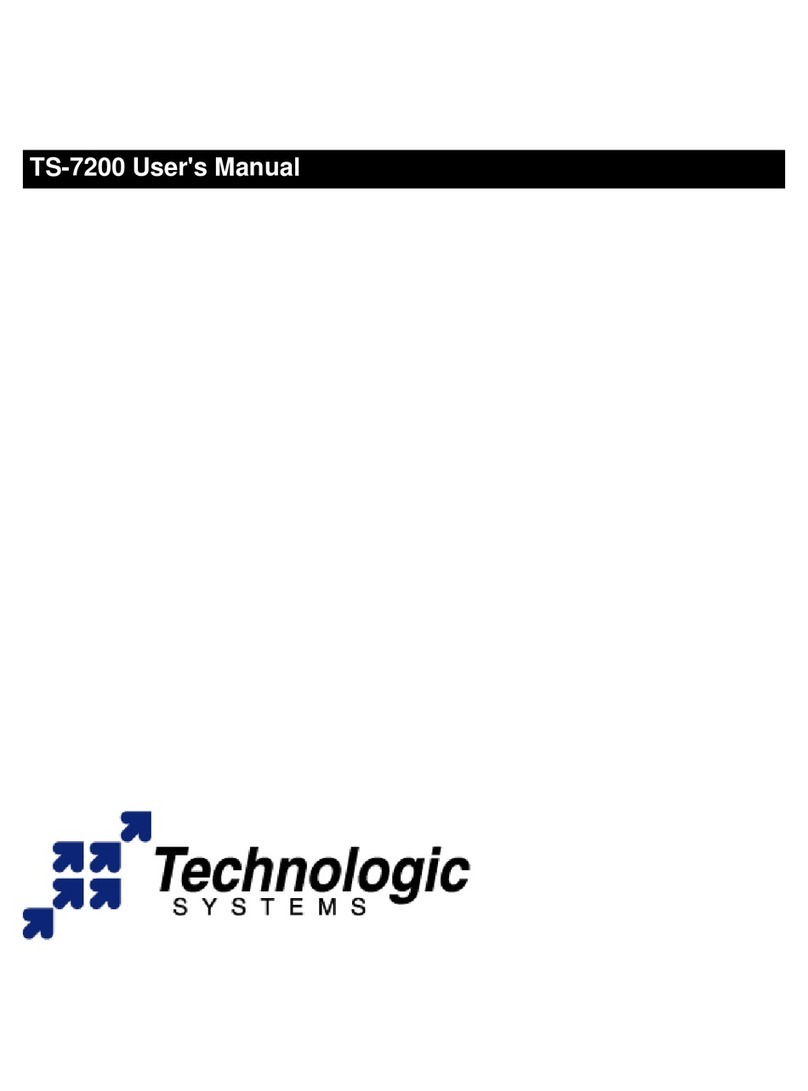
Technologic Systems
Technologic Systems TS-7200 User manual

Technologic Systems
Technologic Systems TS-5700 User manual

Technologic Systems
Technologic Systems TS-7300 User manual
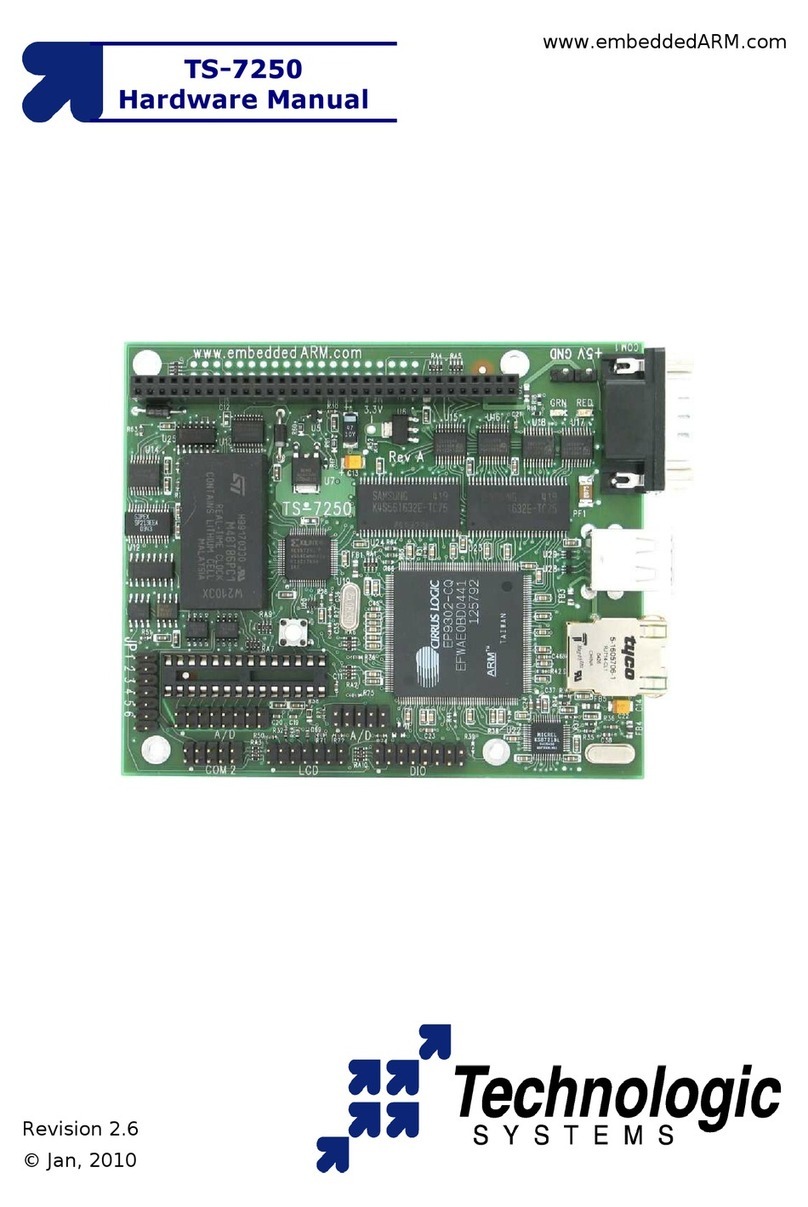
Technologic Systems
Technologic Systems TS-72XX series User manual
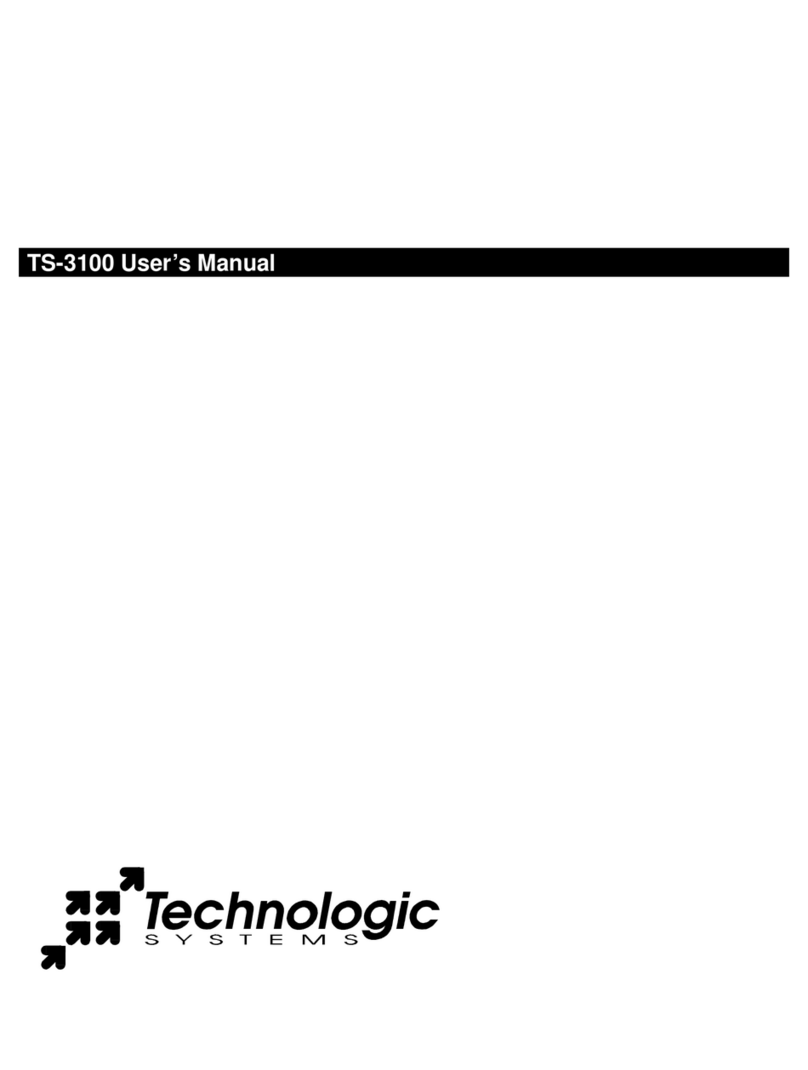
Technologic Systems
Technologic Systems TS-3100 User manual

Technologic Systems
Technologic Systems TS-2800 User manual
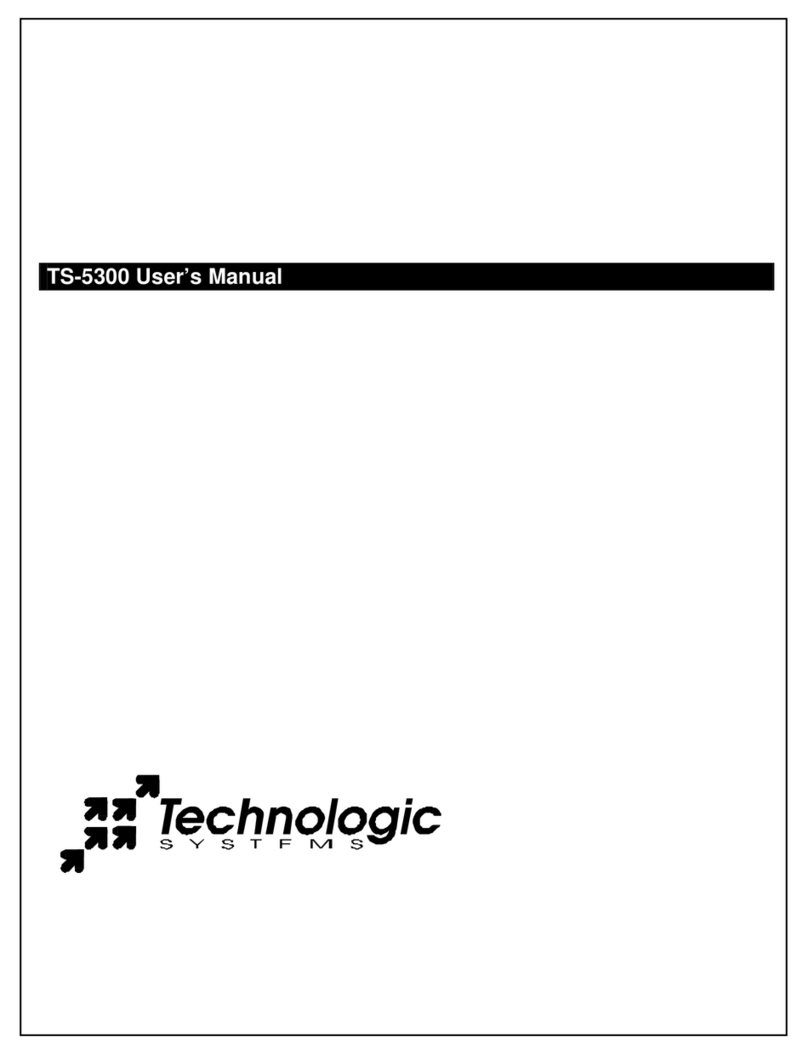
Technologic Systems
Technologic Systems TS-5300 User manual
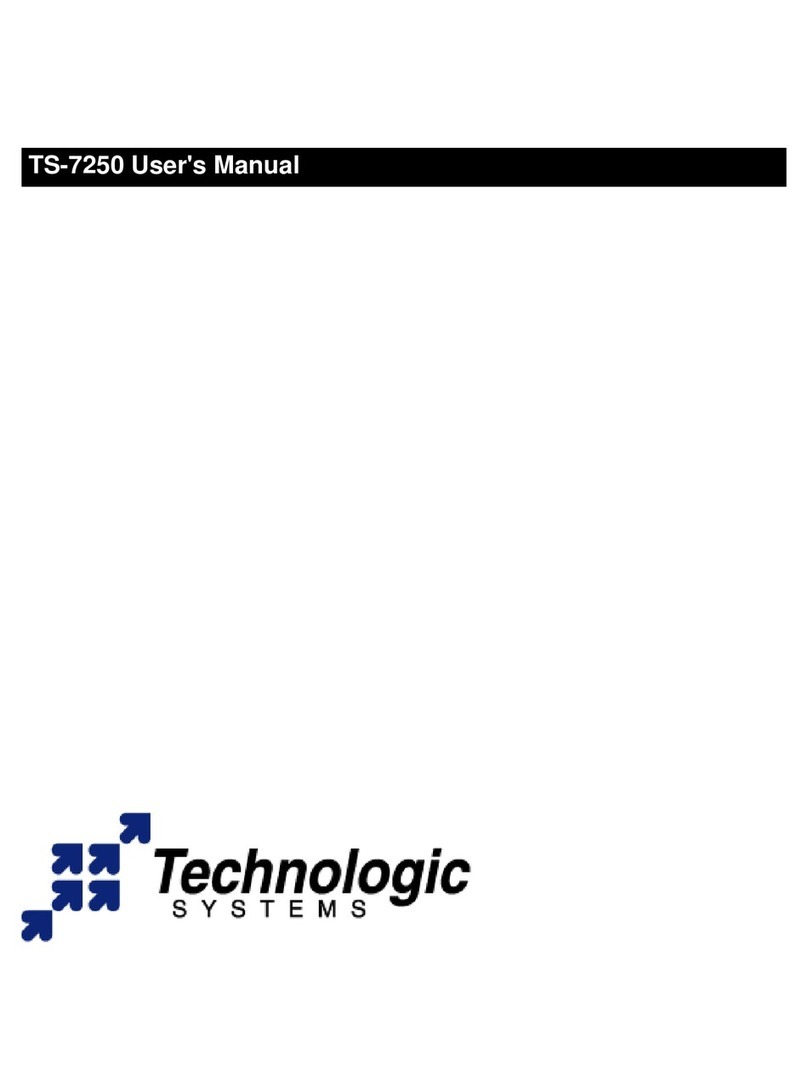
Technologic Systems
Technologic Systems TS-7250 User manual
